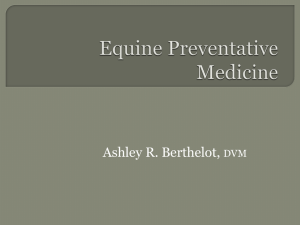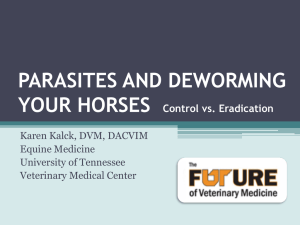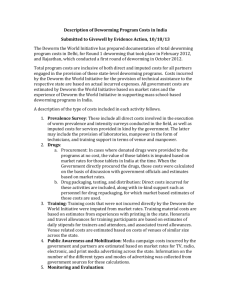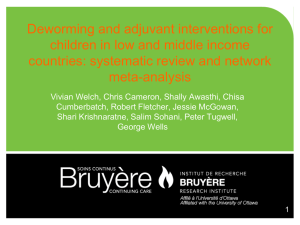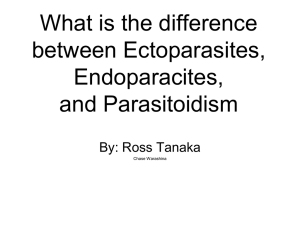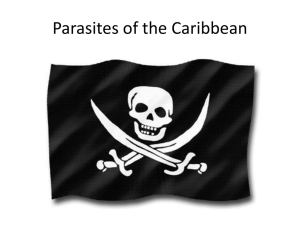Parasites, Part II
advertisement
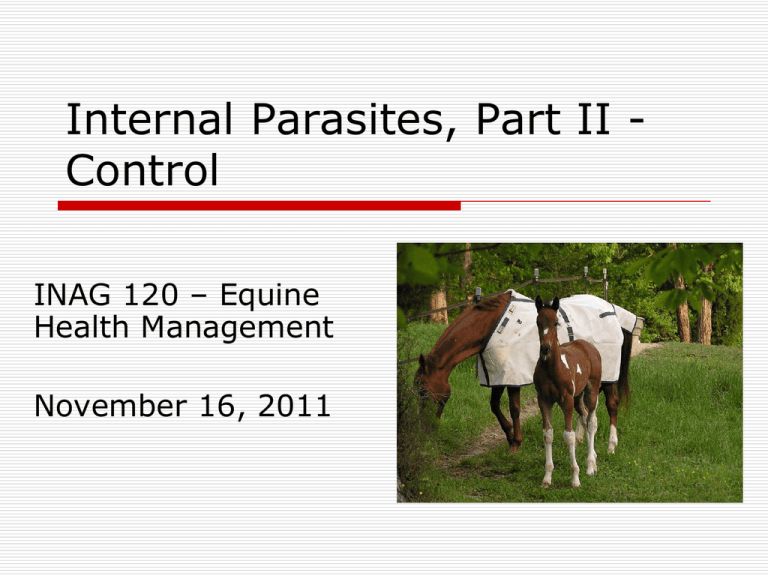
Internal Parasites, Part II Control INAG 120 – Equine Health Management November 16, 2011 Deworming Protocols Rotational Purge Deworming: Goal is to keep the load of eggs and larvae to a minimum Done every 8-12 weeks via oral paste Kills adult and/or larval stages of worms inside the horse before they start producing eggs Drawbacks of Purge Deworming If other horses in same area not dewormed when needed, environmental reduction won’t work Some parasite eggs can live as long as 30 years in the soil! Immature worms mature worms = migration through intestinesand other tissues = damage! Success depends on timing Many purge dewormers don’t kill bots Myths: Vets must tube-worm for it to be effective Only way to guarantee that all the drug is given Old dewormers were irritating or badtasting Myth: Toxicity will build over time in my horse Organophosphates (used in 60’s and 70’s) did cause problems Major concern with modern dewormers: Ascarid impaction in foals Myth: Dewormers aren’t safe for use in broodmares If drug label says it’s safe for mares: Manufacturer must TEST it for FDA approval Requires 2 years of demonstrated efficacy The Pfizer Babies of CSU Praziquantel study in France Quest? Myth: Diatomaceous Earth is just as effective as chemical dewormers Herbs and other compounds are not required to be tested (not FDAcertified) No scientific evidence supports use as dewormer Myth: Rotational deworming will prevent development of resistance Rotational deworming started about 40 years ago Reason was NOT resistance Earlier dewormers were not broadspectrum Purge Deworming Drugs How they work Classes & Brand Names Benzimidazoles (Panacur Pack) Tetrahydropyrimidines (Pyrantel Pamoate) Heterocyclic compounds (Piperazine) Macrocyclic lactones (Ivermectin/Moxidectin) Isoquinoline-Pyrozines (Praziquantel) Safety and efficacy Dewormer Products All must be approved by FDA Rigorous testing required Must be proven safe and effective Must remove at least 90% of target parasites Most are broad-spectrum Don’t require refrigeration but can be damaged by excessive heat How do they work? Nematocides Death by starvation Death by paralysis Worms can’t store energy Must eat continuously Most parasites will die within 24 hours if eating process is interrupted Paralysis blocks ability to stay in gut Benzimidazoles Interfere with metabolism on a cellular level Bind to a particular structure, thereby blocking energy metabolism Because of mechanism of action, can also kill eggs Available in granules, paste and suspension More effective when given several days in a row Panacur Powerpac 5 Days of Panacur (Fenbendazole) at 2x dosage Kills everything Good for new horses coming into your herd as treatment Good for all horses moving to new area where there were no horses in the past Pancur Powerpac Panacur Powerpac Benzimidazoles Generic Name Brand Name Safety Level Fenbendazole Panacur, Safeguard 100X Oxfendazole Benzelmin 10X Oxibendazole Anthelcide EQ 60X Benzimidazoles Effective control of following parasites: Strongyloides (except benzelmin) Ascarids Large strongyles Pinworms NOT Bots NOT Small Strongyles Exception is Panacur PowerPak Tetrahydropyrimidines Say that 5 times fast… Mimic activity of acetylcholine (a neurotransmitter that causes muscle contraction) With tetrahydropyrimidines, contraction is permanent rigid paralysis of parasite Fastest activity of any deworming product Only affect adult parasites (not larval stages) Parasites bounce back quickly Paste, suspension, and pelleted forms Tetrahydropyrimidines Generic Name Brand Name Safety Level Pyrantel Pamoate Exodus, Rotectin-P, Equi-Cide, PSI’s suspension, LiquiCare P, Strongid Paste 20X Pyrantel tartrate Strongid C (2X), Continuex (2X) -- Tetrahydropyrimidines Effective against the following parasites: Ascarids Large Strongyles Small Strongyles Pinworms NOT effective for Bots NOT effective for Strongyloides Effective for tapeworms when given at twice the normal dosage Heterocyclic Compounds Only one used in horses (Piperazine) Depolarizes muscle membranes – resistant to acetylcholine Worms become paralyzed Limited to adult parasites Available only in powder and liquid (stomach tube), pelleted Brand name: Piperazine (1X safety factor!) Macrocyclic Lactones Act on parasite’s nerve and muscle cells Normal transmission of stimuli disturbed Flaccid paralysis inability to feed or swallow nutrients Most potent killers! But, slow to act Ability to kill external parasites Lice, mites, ticks Macrocyclic Lactones Generic Name Ivermectin Moxidectin Brand Name Zimecterin, Rotation 1, Ivercare, Equell Quest, Quest Plus, ComboCare Safety Level 60X 3X - 5X* Macrocyclic Lactones Effective against the following parasites: Strongyloides Ascarids** Large Strongyles Small Strongyles (adult only – ivermectin; all stages - moxidectin) Bots Pinworms Isoquinoline-Pyrazines New kid on the block NO ACTIVITY AGAINST NEMATODES! Effective only against tapeworms Disrupts worm’s outer layer worm can’t maintain fluid balance Generic name: Praziquantel Brand names: Equimax, Quest Plus, ComboCare Gel, and Zimectrin Gold Purge Deworming Sample Adult Horse Program (Maryland): February: Deworm with Ivermectin + Praziquantel to kill bots and Tapeworms April: Deworm with Moxidectin to kill encysted strongyles August: Deworm with Ivermectin or Ivermectin + Praziquantel to kill bots and tapeworms October: Deworm with Oxibendazole December: Deworm with Ivermectin to kill bots Problems with rotational deworming as we know it Reasons for deworming often not known Drug chosen may not be effective against parasite present in horse Don’t discriminate between horses in different parts of the country (i.e. Florida vs. New York) Horses vary widely in susceptibility to parasites How should we deworm, then? Target parasites Tapeworm – once a year, during spring or autumn (more often for known problems) Bots – must enter host prior to winter, deworm late autumn/early winter Large strongyles Most horse owners have unknowingly eradicated large strongyles already Treat all horses at intervals of 6 months for 18 months Small strongyles present greatest problem today Targeting small strongyles Objective of control NOT to “kill worms” Prevent contamination of environment with eggs Kill female worms before they reproduce Environmental factors All horses pass strongyle eggs at a predictable time post-treatment Infectivity of eggs is dependent upon environmental factors Targeting small strongyles… Environmental factors… Northern states: Hatching and development during spring, summer and autumn Autumnwinter favorable for persistence! Southern states: Hatching and development during autumn and spring Summer: development and survival poor; winter ok Targeting small strongyles… Host factors Individual horses differ! Routine deworming may be unnecessary for some horses in a herd Categorize horses Perform quantitative fecal examinations Anthelmintic Issues FECRT (Fecal Egg count Reduction Testing) Know expected egg reappearance periods for the different compounds Determining Strongyle Contaminative Potential Requires fecal egg counts! If horses haven’t been dewormed recently: 20-30% = high egg counts 30-50% = low egg counts Less than 150 eggs per gram = Low Contaminators Greater than 500 EPG = High Contaminators Examine fecal samples 4 weeks after expiration of egg reappearance period Expected Egg Reappearance Periods Anthelmintic Expected Egg Strongyle Reappearance contaminative Period Period Benzimadazoles 4 weeks 8 weeks Pyrantels 4 weeks 8 weeks Ivermectin 8 weeks 12 weeks Moxidectin 12 weeks 16 weeks Sample Schedule for Deworming October – Moxidectin and Praziquantel for ALL horses November, December, January, February – NOTHING (too cold) March – FEC, identify contaminators Ivermectin to all horses April – NOTHING May – FECRT Strongid to moderate and high contaminators from March Recheck fecal in 10-14 days June – Strongid to high contaminators July, August – NOTHING (too hot) September – Strongid to moderate and high contaminators Slow Rotation A recommendation by some parasitologists Rotate annually: Moxidectin – year one Strongid – year two Ivermectin – year three Panacur – year four Deworming Protocols Daily Dewormer: Prevents damage done by immature worms migrating through internal organs Few worms will survive to maturity few to no worm eggs in manure decreased likelihood of reinfestation of environment Drawbacks of Daily Deworming Active ingredient does not kill bots You will have to give an ivermectin twice per year! Light infestation may lead to natural immunity, dailies may prevent that Not “natural” care even though no studies have shown any toxic effects Accumulation over time? Daily Dewormer Schedule Spring Thaw: Ivermectin or Moxidectin to kill bots Spring – early summer: daily dewormer June 1: if tapeworms are a problem, double-dose of pyrantel pamoate or praziquantel June 2 – killing frost: daily dewormer Killing frost day: Ivermectin or moxidectin to kill bots Day after – spring thaw: Daily dewormer Anthelmintic Resistance Drug resistance = ability of worms in a population to survive a treatment that once was effective against the same population Same drug Same dose Same parasite VERY common Resistance High mutation rate among some worms 1. Small number of resistant worms present 2. Deworm – kills off non-resistant worms 3. Resistant worms survive and reproduce, population grows Does resistance exist in horse populations? Small strongyles = most problematic internal parasites in horses Wide range of symptoms Rough hair coat Poor growth Suboptimal performance Life-threatening chronic diarrhea, colic, and severe weight loss Most effective control = deworming medications Some small strongyles are resistant to dewormers! Does resistance exist in horse populations? Resistance to Panacur on 90% of the farms tested 20% of farms - resistance to Strongid No evidence of resistance to Ivermectin on any farm Few farms were tested Ivermectin resistance may exist elsewhere Ivermectin-resistant parasites have been found in sheep and goats Continue using ivermectin, moxidectin, and even pyrantel – check for resistance in your herd No benefit to rotating dewormers with each treatment Slow rotation recommended: one class per year Management to control Parasites Pasture Management! Remove feces from congregation areas Drag pastures regularly to break up manure Do not overstock pasture! Rotational grazing Biological vacuum cleaners Compost manure before spreading
